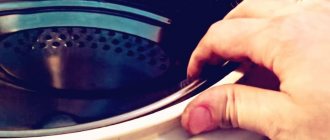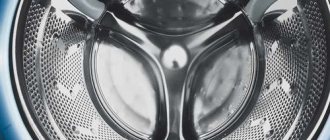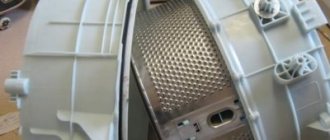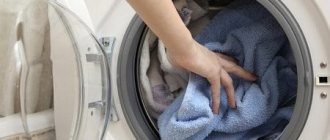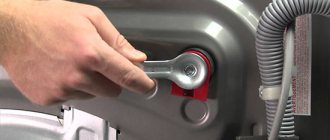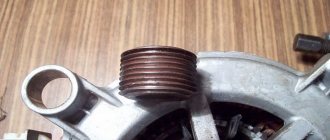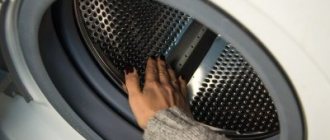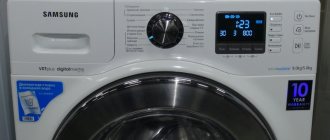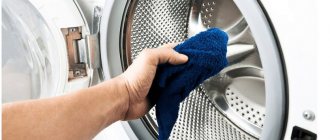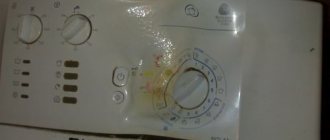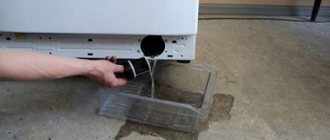One of the most common problems in the operation of a washing machine is a complete or partial breakdown of the drum, as a result of which it begins to rotate poorly or not at all. In this case, determining the cause of the malfunction is the most important step, which will determine further actions. The most common reasons why the washing machine drum does not spin well include:
- overload of laundry;
- damaged engine drive belt;
- engine breakdown;
- malfunction of the carbon brushes of the electric motor;
- imbalance of the drum mechanism.
Why does the drum rotate poorly?
In such a situation, you should definitely be concerned about the reasons for the breakdown. Based on this, the most suitable methods of repair work will be assigned. Often problems with element rotation include the following:
- Overload. Many modern washing machines that have special sensors do not start the process if there are too many items in the drum. When you suspect that you have overloaded the machine, it is recommended to cancel the program and take out a couple of things. This measure will allow the machine to continue operating as usual.
- Worn drive belt. In such a situation, rotation of the drum will only be possible by hand; the electric motor will not do this. However, the belt might not wear out, but simply fly off from the landing site.
- Electric motor brushes are worn out. In washing machines with commutator electric motors, this place is the most vulnerable. If the required motor maintenance has been performed over the entire period of operation, then there is a possibility that the brushes will have to be replaced. As a rule, after such a procedure, the machine’s ability to work is fully restored.
- The electronic programmer has failed. The most complex breakdown, because the work of reflashing or replacing the modular unit will require certain financial expenses.
- The electric motor is malfunctioning. When the drum rotates unevenly or does not rotate at all, the problem may lie in the electric motor. It probably broke, or a short circuit occurred - more likely problems in this situation. The repair is complex; it is recommended to hire an experienced specialist.
How to prevent problems
To reduce the likelihood of the drum jamming, you should check the contents of the pockets before you start washing. When using equipment in areas with unstable voltage, it is necessary to provide a protective unit that will prevent overload of electrical and electronic components. Manufacturers do not indicate the service life of the belt drive; it is recommended to check the condition of the parts at least once a year. After several washes, you should remove the drain channel filter, which is cleaned of adhering dirt (at the same time, the pump impeller is inspected).
We figure out the problem ourselves
Primary diagnosis of breakdowns will be within the capabilities of any user. To do this, you must follow certain procedures:
- check the maximum weight of the laundry in the instruction manual,
- check that the door is not locked. As a rule, the drum stops spinning if the water drain filter is clogged,
- We try to turn the drum with our hands. If everything is normal, and a problem is observed during the automatic washing process, you should look for the cause in the wires, tachogenerator device, control module,
- It is imperative to inspect the cavity between the machine tank and the drum for the presence of foreign objects. If everything is normal, the heating element may have failed. The drum may also stop rotating due to a non-working heating element, thereby completely blocking the washing process,
- inspect the drive belt. It should be corrected or completely replaced with a new analogue,
- The machine is disassembled and inspected to see if there are any problems with the bearings. It is quite possible that they also need to be replaced.
Other reasons
The drum may stop rotating if the equipment is overloaded with laundry. The electronic controller detects increased load on the motor and automatically interrupts the work cycle with an error code displayed. After removing some of the items, the operation of the machine is restored. A possible reason for the drive to turn off may be things that have clumped together; the controller detects the beating of the drum and turns off the unit. After distributing the laundry evenly by hand, the washing machine works flawlessly.
If there is no rotation when spinning clothes, then the cause of the defect is a clogged drain channel or a breakdown of the electric pump. The sensor that determines the liquid level in the tank may fail. The electronic controller displays an error code on the screen, and repairs are made based on decoding the information received. The design of the machines is designed for a voltage of 220 V (taking into account the tolerance range); if the parameter drops below the permissible limit, the equipment is blocked.
Some electric motors have a starting capacitor; if the element breaks down, the rotor cannot spin up. The element is located on the motor housing or in the power circuit (depending on the manufacturer of the machine). The electronic controller checks the functionality of the electrical components; if damage to the heater is detected, engine operation may be blocked. In this case, it is necessary to check the heater with a test device (for breakdown and breakage).
We carry out repairs
Let's consider how to act in a given situation:
- A foreign object has entered. Such situations arise quite often when we forget to check our pockets before washing. All small items in most cases remain in the drum itself or the sealing element surrounding the loading door. Sometimes, during washing, such items fall into the gaps created by the drum and tank of the machine and get stuck there, becoming an obstacle to normal rotation. This suspicion is verified quite simply. First we try to rotate the drum manually. If it stands still, it means it is fixed by some thing or foreign object. To find out their location in relation to the tank, you should slowly rotate the drum with your hands, shining a flashlight into the space. To gain access, you will have to remove the heating element and pull out the foreign object through the resulting niche. Magnets or wire hooks can be a good help for this type of work. The problem is, if something is stuck in the top or side part, you will have to disassemble the tank. This is not the best solution, because then you will have to seal the seams with sealant or cold welding.
- Bearing failure. You cannot turn the drum with your hands, or do it with great difficulty, hearing creaking and grinding noises? Most likely, the problem is hidden in the seals and bearings. The first element is represented by special sealing seals that protect the bearings from moisture. Gradually, its integrity deteriorates, the liquid begins to wash out the lubricant on the bearings, causing corrosion. The breakdown is eliminated by completely replacing the failed elements. The work is complex, it is recommended to invite a specialist. By the way, the process is expensive. For example, on Samsung machines, its cost is such that it is better to purchase a new washing machine.
- The filter is clogged. At such moments, the machine stops in emergency mode, stopping the process and blocking the door. You can clean the filter yourself. The operating instructions describe the procedure in detail. Most often it is located at the bottom. Carefully unscrew the lid, clean the element and drain the remaining water in the machine. Before performing such work, it is recommended to place a sufficient number of rags under the washing machine to absorb any water spilled on the floor.
- The drive belt has fallen off. It is stretched from the drum to the motor, and from long work it stretches, stopping normal torsion. With the unit switched off, you can perform a check - spin the drum. If the movement is free and there is no noise from the electric motor, then it is the belt that is damaged. It often falls off due to uneven loading or overloading of machines, dries out, loses elasticity, and becomes brittle. To check its condition, you can remove one of the side panels of the washer. A belt that has fallen off is installed using the principle of a bicycle chain. If necessary, a new analogue is purchased. The belt is pulled with such force that when you touch it, it should make a ringing sound.
- Motor failure. In older models, the capacitor most often fails - a cylinder installed next to the motor. If it fails, the engine is unable to turn on, and the drum, naturally, also does not rotate. In such a situation, it is necessary to replace the capacitor. A common occurrence is brush wear. Over time, they become short and no longer reach the engine manifold, without transmitting the rotational process to it. The problem is solved by replacing the brushes and first cleaning the commutator from dirt. The motor is dismantled. To do this, remove the back panel and turn the washer on its side. The mounting screws are unscrewed and the terminals with wires are disconnected. After installing the brushes, rotate the motor pulley. If it works without noise, then the job has been done correctly.
- Problem with wires. It is possible that there is no voltage in the wiring. This may happen due to a failure of the control module or a malfunction of the wires powering the electric motor. Each element will have to be checked with a tester, isolated or completely changed.
- Uncontrolled opening of the drum doors occurs. This is typical for models with vertical loading of laundry. The doors swing open even during the washing process, although the design of the elements completely eliminates this possibility. The worst thing is that the tank is destroyed or the drum becomes deformed. Intervention by an experienced specialist is required.
- Failure of the module responsible for control. It is responsible for the performance of each individual washing machine unit. Incorrect operation may cause the drum to stop. You will have to replace the element or try to repair it. This will require knowledge and special skills, otherwise independent actions can only aggravate the problem.
What to do if the car engine does not work
A visual inspection of the unit will help identify the breakdown. How to get to the electric motor:
- Disconnect the SM from the network.
- Move the equipment away from the wall to make dismantling easier.
- Unscrew the mounting screws and remove the back panel.
All that's left is to get the motor. Remove the belt from its pulley, disconnect the contacts and unscrew the bolts.
To identify the problem, you need to connect the rotor and stator windings. Connect a 220 Volt AC source to the free connectors. Is the node working? So everything is fine. Does not move? That means it's faulty.
Pay attention to the brushes and slats. Determine the degree of their wear.
Replacing brushes
If upon inspection it turns out that the length of the brushes is less than 5 mm, replace them. Prepare identical parts in advance, because they are different for each washing machine model.
When you start the engine, the brushes spark, but when checking, you noticed that they were almost not worn out. This is possible when installing new elements or connecting equipment for the first time. As soon as the brushes rub in, the sparking will stop.
To replace, disconnect the contacts of the parts and remove them from the assembly. Install new items.
Useful tips from experts
When using a washing machine, it is recommended to follow some important requirements in order to protect the drum and other components from possible damage:
- always empty your pockets when putting things in the wash,
- load the maximum permitted weight; in case of overload, stop the program to lighten the drum,
- Do not try to forcefully rotate the drum for a long time if it stops working. This is only allowed to be done to check the causes of the breakdown,
- Use descaling products carefully. It is recommended to purchase them only in specialized stores, use them in accordance with the instructions,
- When replacing items that have lost their functionality, purchase only branded analogues that match your markings. Fake parts will not work for a long time and will cause further malfunctions.
By following these simple rules, you can extend the life of your washing machine.
Faulty tachogenerator
Before carrying out diagnostics, the washing machine must be de-energized. A common reason that a car suddenly picks up speed may be a malfunction of the tachogenerator. This part is designed to regulate the speed of the engine. To determine the cause of the breakdown, it is necessary to disconnect the engine from the tank (the tachogenerator is installed on it) and carefully ring the power circuit, starting from the tachogenerator to the engine connector. The tachogenerator is located near the rear wall of the engine, in a small recess. It is also necessary to visually inspect the part for the presence of burnt or melted parts.
Studying the situation
After the preparatory process is completed, you can begin a detailed study of the breakdown of the washing machine. You can do this yourself if you follow simple steps. Then the breakdown is quickly determined and a repair method is prescribed accordingly.
We must carefully remember the moment when the drum in the car stopped spinning. To do this, there is an option to look at the removed laundry. For example, if the laundry is just wet and there are no traces of powder on it, then the drum probably stopped spinning during the spinning procedure. If the presence of washing powder is observed in the items that were removed from the washing machine, then the drum of the unit has stopped rotating directly while washing the clothes. Now you need to turn it yourself
To do this, you need to grab the inner ribs of the drum with your hand and give it centrifugal force. If in this process the drum does not want to spin, then most likely the reason for this stop is that there is a foreign object that does not allow the drum to spin. If the drum itself rotates quite freely, then the whole problem will be in the electronic filling of the washing machine. When determining the reason why the drum of the washing machine does not spin, one must also take into account such a circumstance as drum overload. Quite often, users, in an effort to wash a large volume of laundry in one process, allow a violation of the drum load
Then it can simply stop during the washing procedure. Therefore, as a way out, you can try to divide this laundry into two parts and wash it again. In connection with this point, it should be noted that the latest modifications of washing machines already have a special function that provides for monitoring the weight of the laundry loaded into the drum. For this purpose, special sensors are installed. If, as a result of loading, the nominal weight is exceeded, the sensor stops the wash and the drum stops spinning. At the same time, in a number of models there is also a visual indication, which makes it clear to the user that a weight overload has occurred. It is also necessary to pay attention to external circumstances that may affect the operation of the system. For example, a number of washing machines have a sensor that is very sensitive to water pressure readings in the supply system. If these data do not correspond to the norm, then it will react adequately and de-energize the machine.
Debugg
To access the damaged part of the washing machine, you will need to partially disassemble the household appliance. The best way to access the inside of a household appliance is to remove the back cover.
This option is ideal for disassembling LG or Ariston Hotpoint machines. On some Samsung, Indesit and Bosch models, in order to get to the internal parts, you will first need to remove the top cover of the household appliance. Before you begin disassembling the washing machine, you should remove the power plug from the socket and also turn off the water supply to the device.
The top or back covers are secured with screws that can be easily removed with a screwdriver. After access to the internal parts of the machine is opened, depending on the cause of the malfunction, a certain sequence of actions is performed.
Replacing bearings
If the reason that the drum has come off the shaft is a faulty bearing, then repairing the household appliance is only possible by replacing these parts. The operation is performed in the following sequence:
- The top and bottom weights are removed. As a rule, in order to remove these parts, it is enough to unscrew 4 bolts.
- Carefully remove the drive belt from the pulley.
- The heating element is removed from the tank.
- The plastic clamps of the shock absorbers are removed.
- The springs are released.
- The electric motor is dismantled.
- The pulley is removed from the rotating part.
Now you will have access to the bearing, which should be removed using a special puller. What to do if there is no such tool? In this case, you can use a hammer and any oblong object of small diameter to knock the product out of its seat
When removing a bearing in this way, care should be taken, as careless actions can lead to damage to the rotating part of the household appliance.
When the old bearing is removed, a new part is pressed into its place, after which the car is reassembled in the reverse order.
Shock absorber repair
If the drum falls off due to a faulty shock absorber, then this part can also be easily repaired on your own. When the rear cover is removed, you should find the mounts on the rotating part of the machine to which the shock absorbers are attached. On many models there are at least four such elements, so you should inspect each one for damage.
Sometimes the spring can simply fly off the mount, so to restore the functionality of the device, it is enough to install the shock-absorbing element in place. If the spring breaks, it should be replaced with an original product.
Some models of washing machines use dampers as shock absorbers. If such a part is damaged, you will need to purchase a new product or remove it from a faulty “donor” of the same model.
Replacing the drive belt
Sometimes the reason for the drum moving out of its seat may be a heavily worn drive belt. In this case, you cannot do without replacing this part. This is quite easy to do, because each product has markings, which will make it easy to choose a new belt.
The belt is first put on the electric motor pulley, and then installed on a larger diameter wheel located on the tank. To make the task easier, you can pry the belt with a screwdriver, but even a new, undeveloped belt is usually easy to put on by turning the pulley 1 turn, after first throwing the part onto the wheel.
If the drum in the washing machine falls off, then it is absolutely not necessary to seek help from specialized workshops. You can save a lot if you carry out the repairs yourself according to the recommendations given in this article.
We get foreign objects
So, the belt is in perfect order, let's move on to checking the drum. It is likely that a small object in the form of a clothing button or key got into the free space between the tank and the drum, and the element stopped rotating. In this case, operating the machine is not recommended, as the object may cause jamming or damage to the drum walls. In each case, the situation requires expensive repairs associated with replacing the internal parts of the machine.
It is easy to determine the presence of a foreign object in the tank. To do this, you need to open the loading hatch door and turn the drum manually, first in one direction, then in the other. The presence of resistance, extraneous grinding or ringing will indicate that you are on the right track. All that remains is to remove the foreign object as quickly as possible, and for this there will be difficult steps, since you will have to work with the drain filter or the hole located under the heating element.
The first algorithm of actions is as follows:
- At the bottom right we find a hatch intended for draining;
- open its lid;
- spread rags on the floor;
- remove the garbage filter;
- We clean the body, sleeve, pipes.
Larger items remain at the bottom of the machine tank. To get to them as quickly as possible, you will have to dismantle the back panel, turn off and remove the water heating element. All that remains is to use a flashlight to find a foreign object and remove it using wire or pliers
You will have to act carefully so as not to damage the tank body.
If the drum stops rotating and is completely jammed, the tank must be completely disassembled. We proceed as when replacing a bearing - remove the panels at the top and rear, dismantle the drive, electric motor, dispenser with module, counterweight elements, shock-absorbing devices and other machine components. After completing these works, we take out the main container, disassemble it and remove foreign objects. The difficulty arises if the tank of the car is made in a non-separable form. It will take four hours to complete the cut, and it is better to entrust such work to an experienced specialist.
